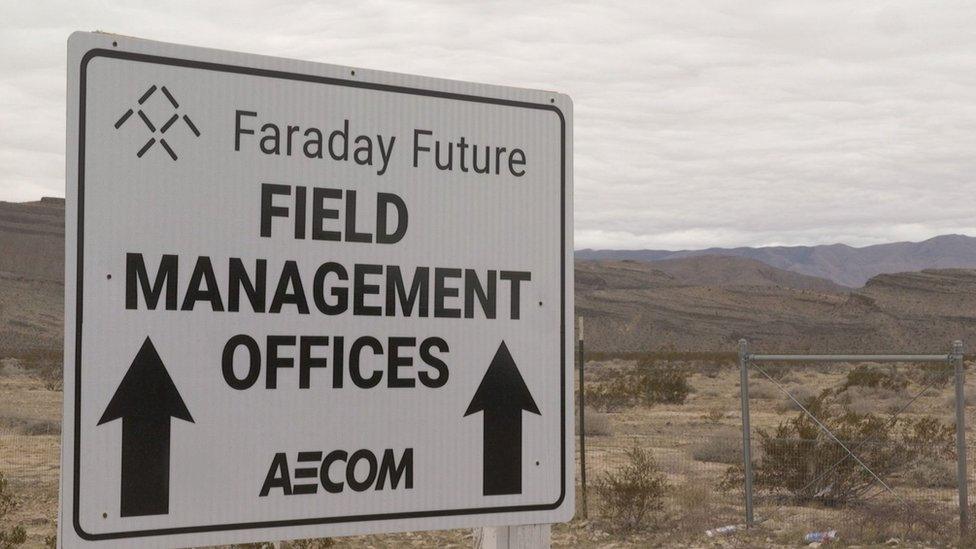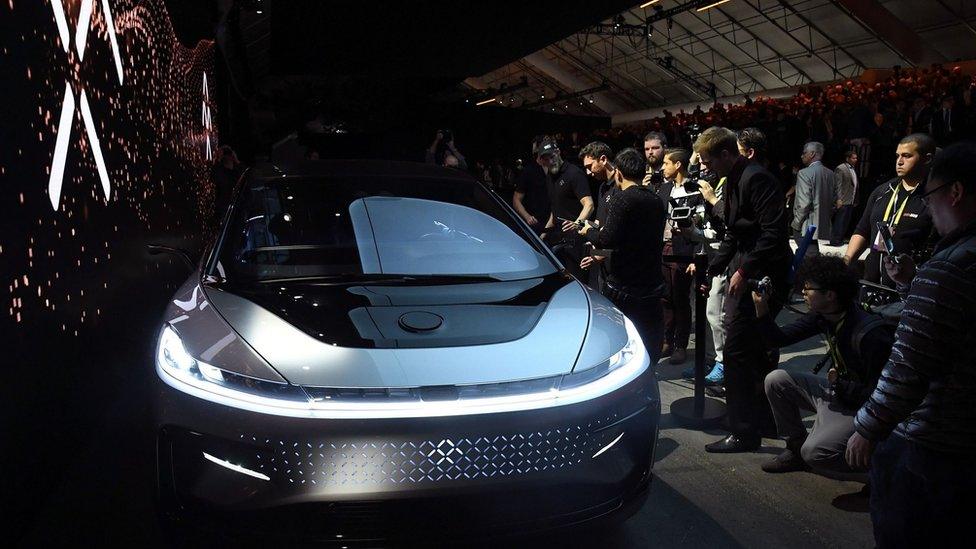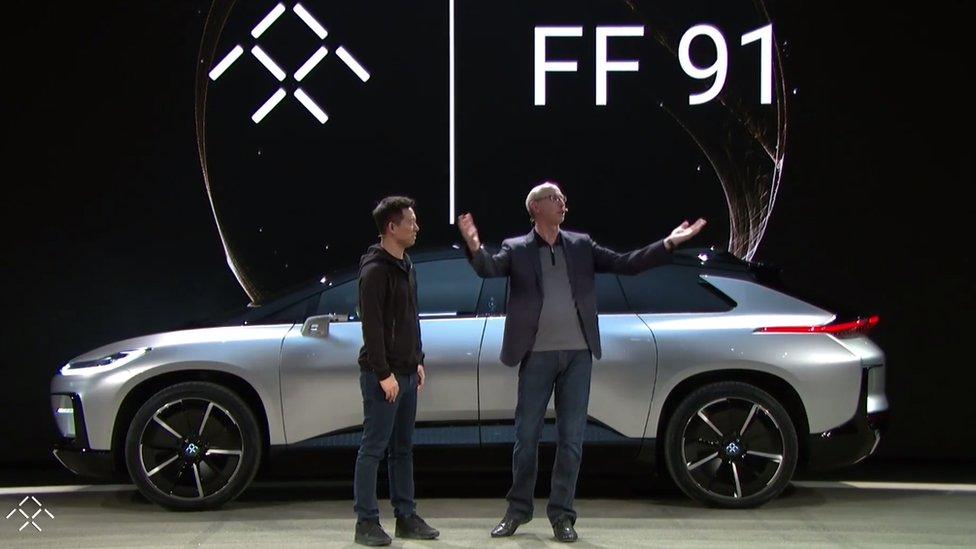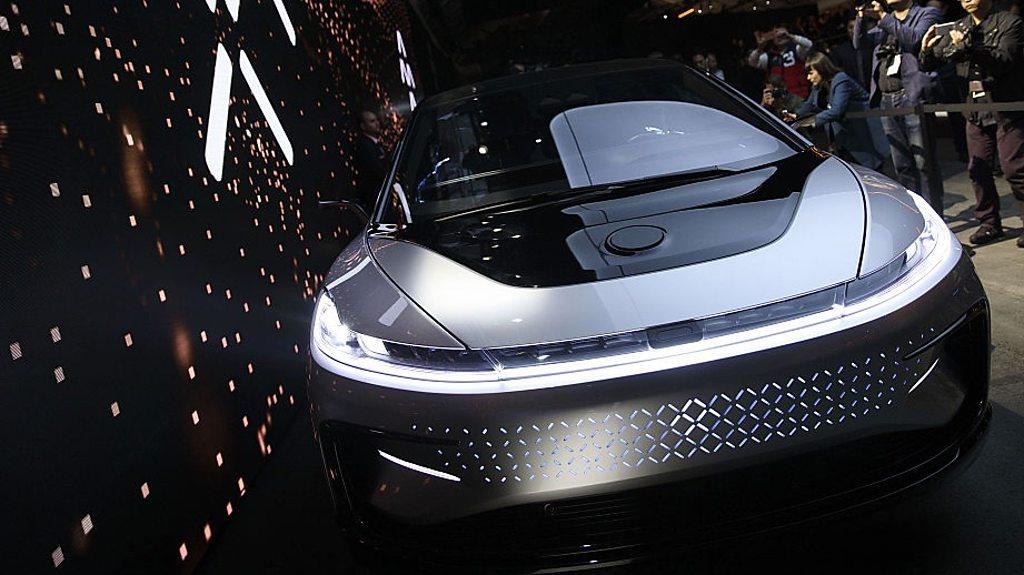Faraday Future's cash flow woe
- Published
- comments
WATCH: Taking a test drive in Faraday Future's FF91
Faraday Future, the company hoping to beat Tesla in the electric car game, had to halt building its factory in order to afford its glitzy CES press event, the firm told the BBC.
The company broke ground on its enormous plant in the Nevada desert in April last year - but work halted in October amid reports the company was in dire financial straits.
Speaking on the record for the first time about the firm’s money woes, Faraday Future’s senior vice president of research and design, Nick Sampson, acknowledged the company was facing "challenges".
"Clearly something like [CES] requires funding and some resources," Mr Sampson told me.
"We are resource-limited at times. [It's] just a matter of keeping the cash flow balance between the different projects we’re trying to do."
No date has been set for work on the site to recommence.
"Things like [CES] have to take priority at this point in time. We’ll be starting again [on the factory] very shortly," he said.
The company was spinning several financial plates, he argued.
"The challenge of building a new company is that it’s not just doing the engineering and R&D work, we’ve got manufacturing to keep aligned, we’ve also got the whole sales and marketing, branding and imaging.
"It’s a matter of keeping the whole programme aligned."
‘Steve Jobs didn’t have it easy’
Faraday Future’s launch was arguably the most extravagant press event at this year’s CES, taking place in a huge venue away from the famous Las Vegas strip. It was attended by the mayor of North Las Vegas, John Lee.
The $1bn plant is being subsidised by around $320m of taxpayer’s money, a deal which has attracted intense criticism, though Mr Lee has insisted the public will not be left out of pocket should Faraday Future pull out of the project.

Faraday Future's contractor, AECOM, has stopped work on the factory but said it is still committed to the project
Little is known about the finances of Faraday Future, other than that its biggest backer is the founder and chief executive of China’s LeEco - a company also embroiled in legal difficulties owing to what suppliers claim are unpaid bills.
Another problem facing Faraday Future, as well as the stalled factory construction, is that several suppliers have begun taking legal action against the firm. Futuris, a company which specialises in luxury car interiors, is suing the firm for breach of contract, demanding immediate payment of more than $10m.
According to a recent report published by Buzzfeed, Faraday Future owes more than $300m.
But that’s typical for a fledgling technology firm, Mr Sampson argued.
"We’ve gone from nothing to where we are today in just over two years," he said.
"Matching the speed of development and building with the inflow of cash doesn’t always match.
"Many companies have had this - Apple and Steve Jobs didn’t always have it easy in its early days. That’s one of the hurdles that we have to get over."
Reasons to be cautious
That kind of comparison - to technology pioneers - is something Faraday Future does often.

An impression of how Faraday Future wants its factory to eventually look
During its CES presentation, it brought up a timeline of milestones including the invention of the lightbulb and the creation of the world wide web. Faraday Future placed itself at the end of this timeline.
"That to me was stepping too far," remarked Tim Stevens, editor at large of motoring news site Roadshow.
If the company does manage to put its first vehicle into production, Mr Stevens said he still had reason to be cautious.
"I’m expecting this car to be in the range of $150,000, maybe $200,000. Far more expensive even than a Tesla Model X.
"That’s a big ask - if they are talking a low-number, high-margin car, they’ve still got to have a production down pat, and the reliability down pat too. Those are things it's taken Tesla a long time to figure out."
Fastest car
Where Faraday Future doesn’t appear to be struggling is with the car itself. The FF91, shown off for the first time at CES, goes like a rocket - 0-60mph (97km/h) in an alleged 2.39 seconds. Faster, it said, than a Tesla Model S (though Tesla’s chief executive, Elon Musk, disputes the claim).
A test drive also demonstrated the car’s ability to park itself completely autonomously. The company hopes drivers will one day be able to leave their car at the side of the road and ask it to drive off and park using a mobile app - like a robot valet.

The FF91 impressed car buffs - the company has promised it will be ready by 2018
However, the technology won’t be a part of daily life any time soon. It will be valet parking "approved by Faraday Future", a test driver told me - a process that will mean adoption across the world will likely be painstakingly slow.
But when it comes to hurdles to leap over, autonomous parking is well down the priority list.
Right now, Faraday Future is a company seemingly operating on a thread.
It is right to acknowledge that getting into the car industry as a brand new player is extremely difficult - which is why so few companies attempt it, and even fewer succeed.
Even behemoths like Apple and Google owner Alphabet have turned their focus more to providing software for established car makers, rather than begin manufacturing themselves.
At CES 2016, when Faraday Future launched a concept car so outlandish it instantly became known as the Batmobile, the company insisted it would defy its critics by 2017.
Has it done that? Partly - there is a car, and it’s rapid.
But building on that achievement and turning it into a mass-produced vehicle and a viable business? By next year?
That seems unfathomably ambitious.
Follow Dave Lee on Twitter @DaveLeeBBC, external and on Facebook, external
- Published4 January 2017

- Published4 January 2017
